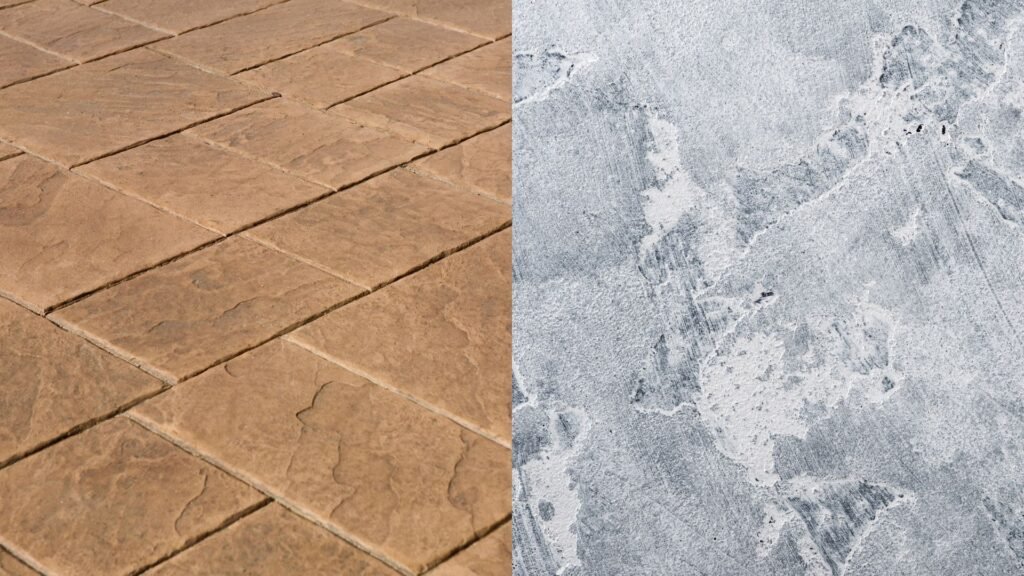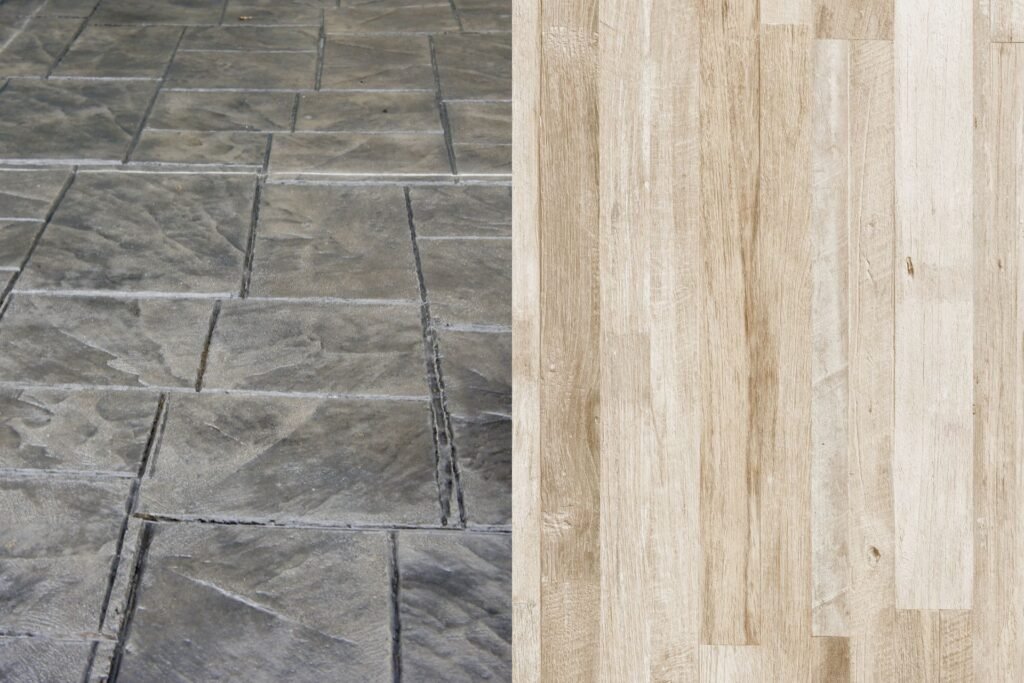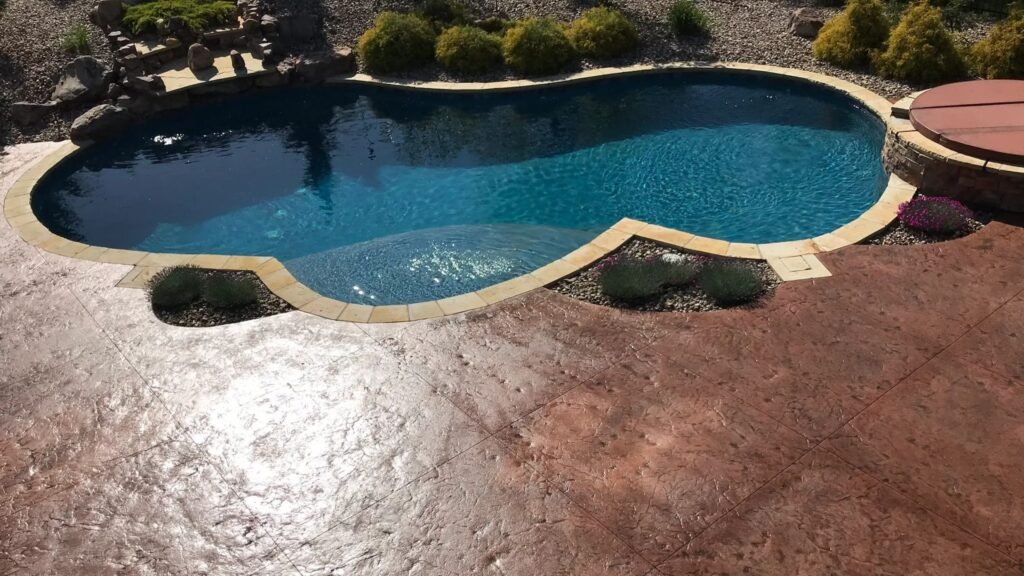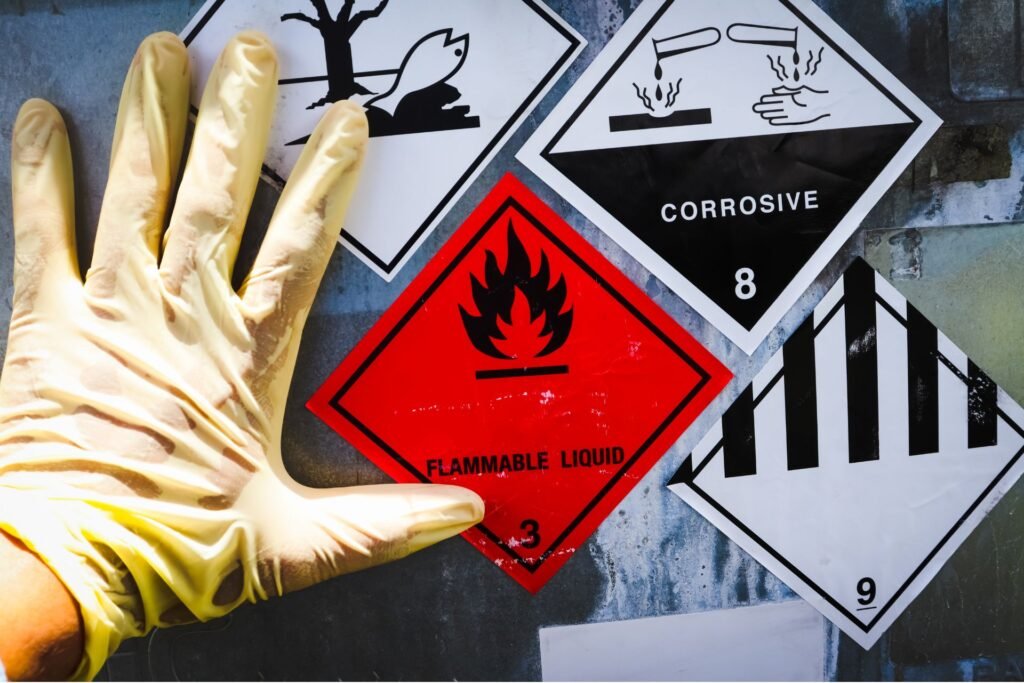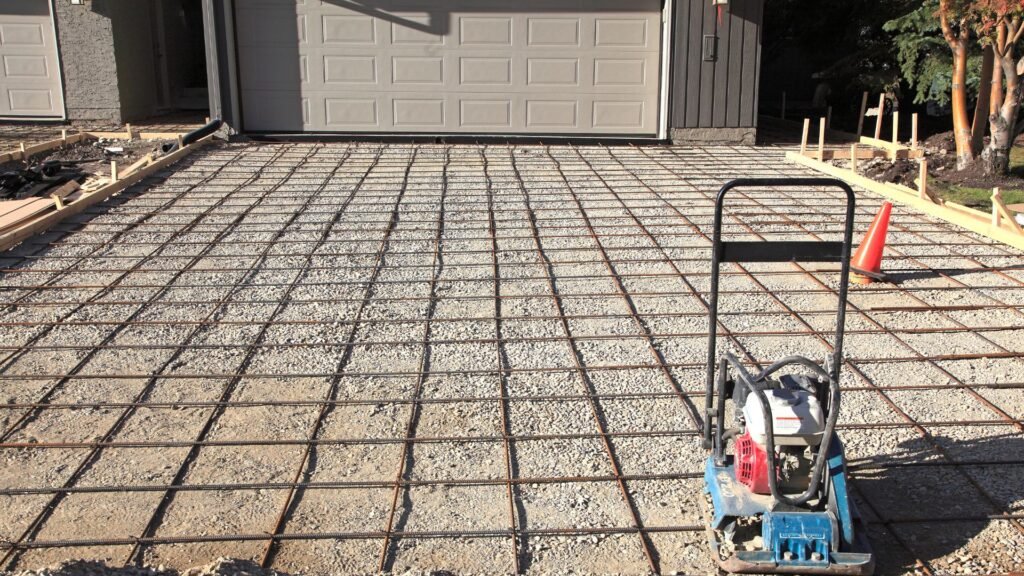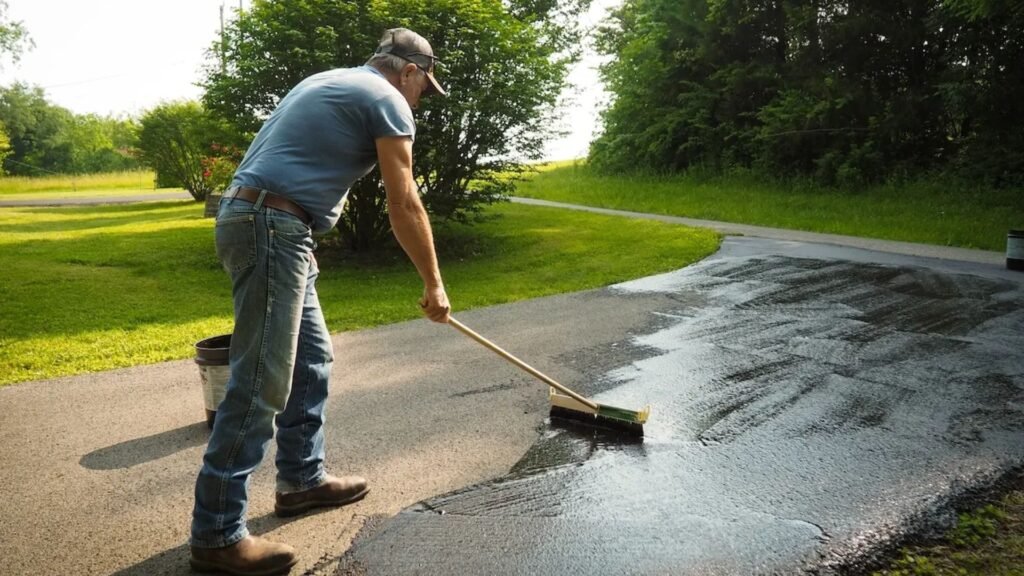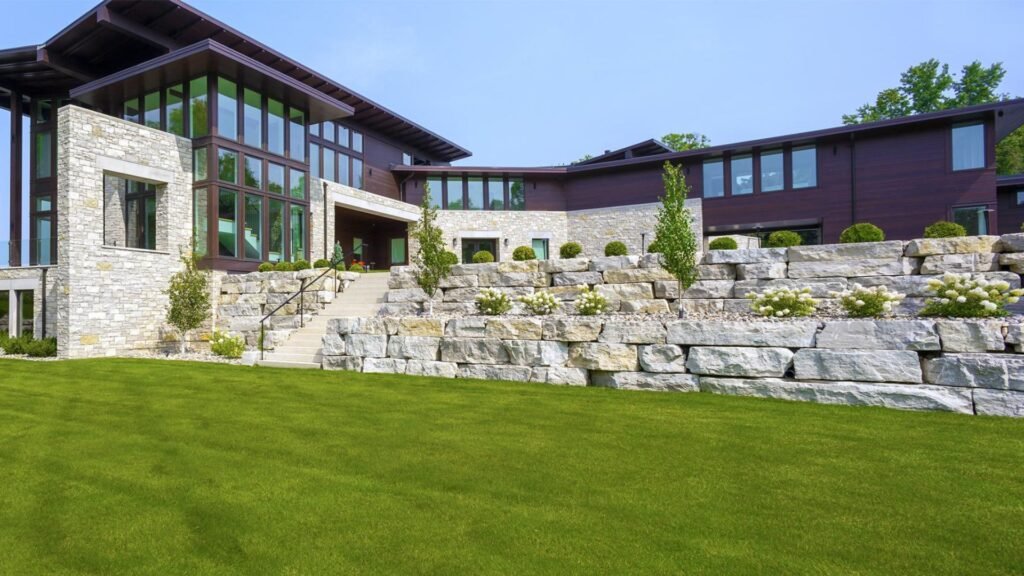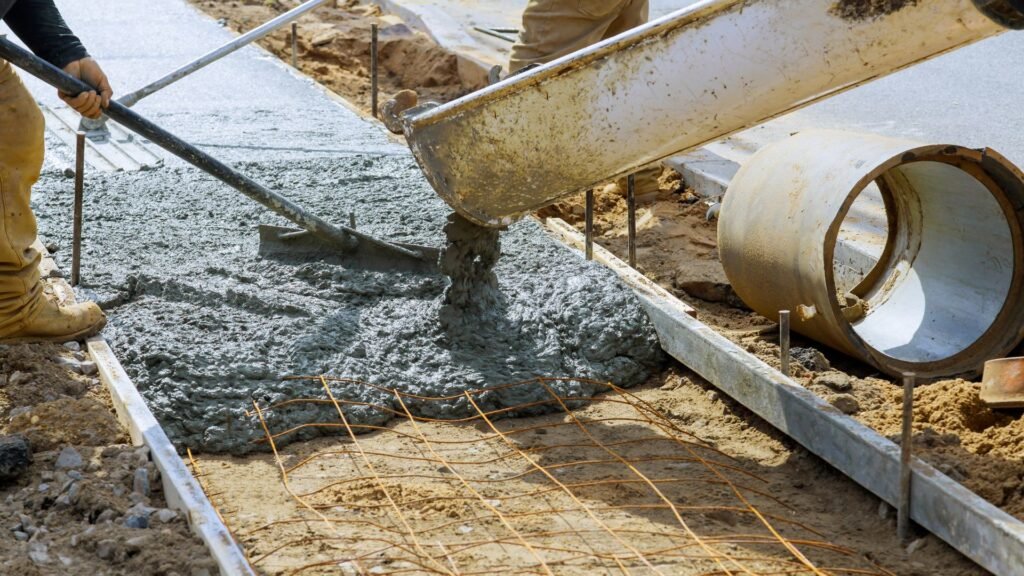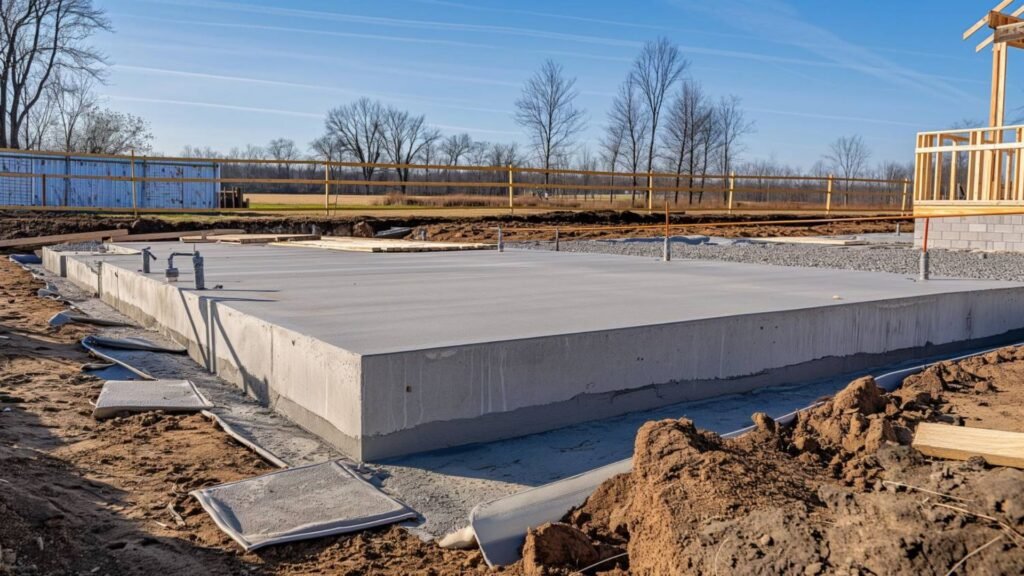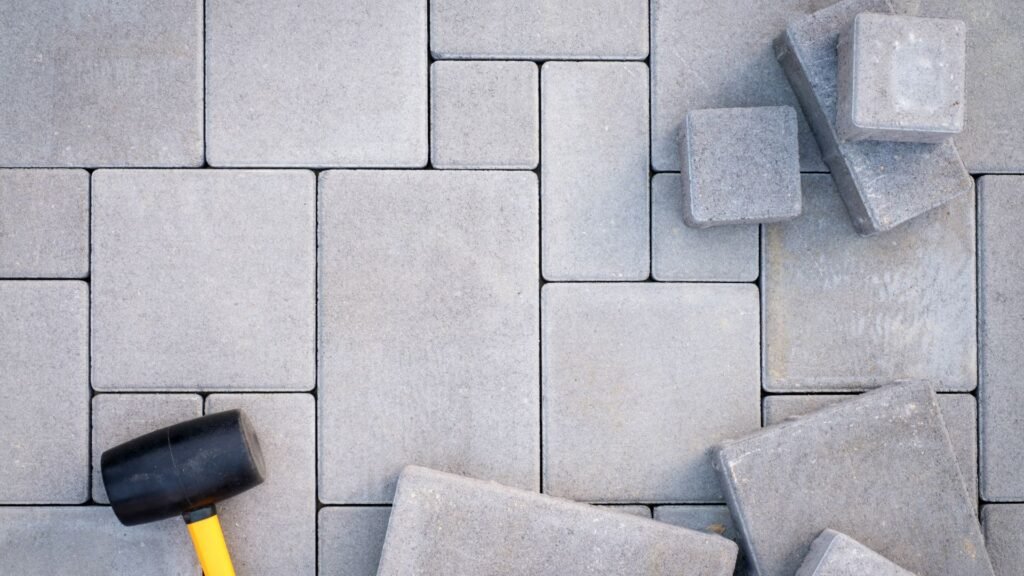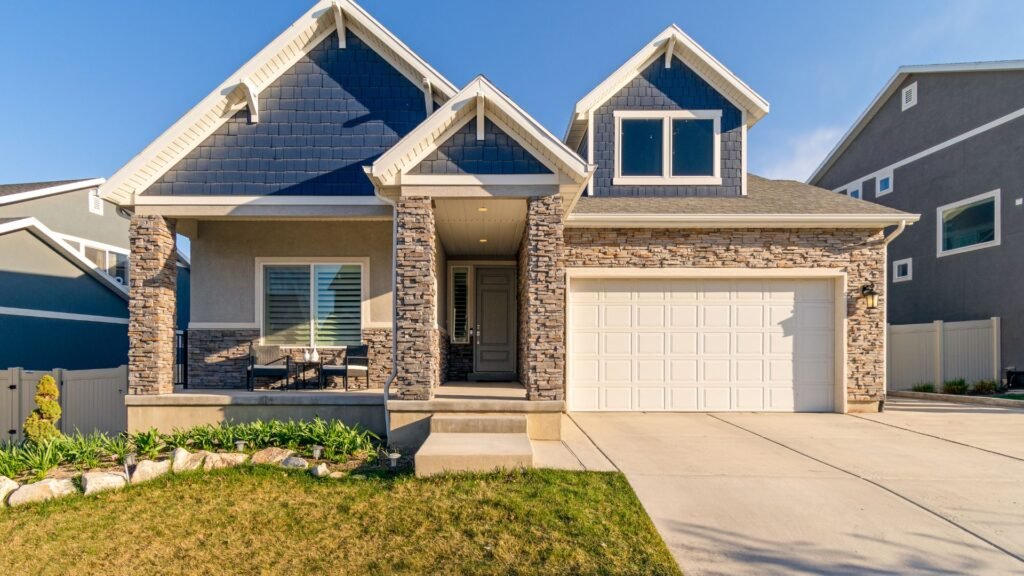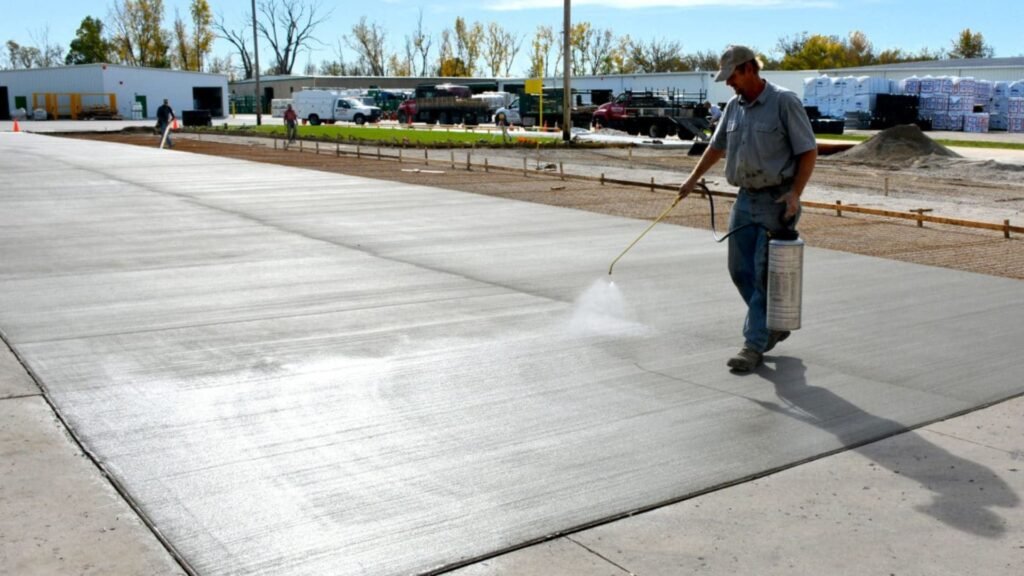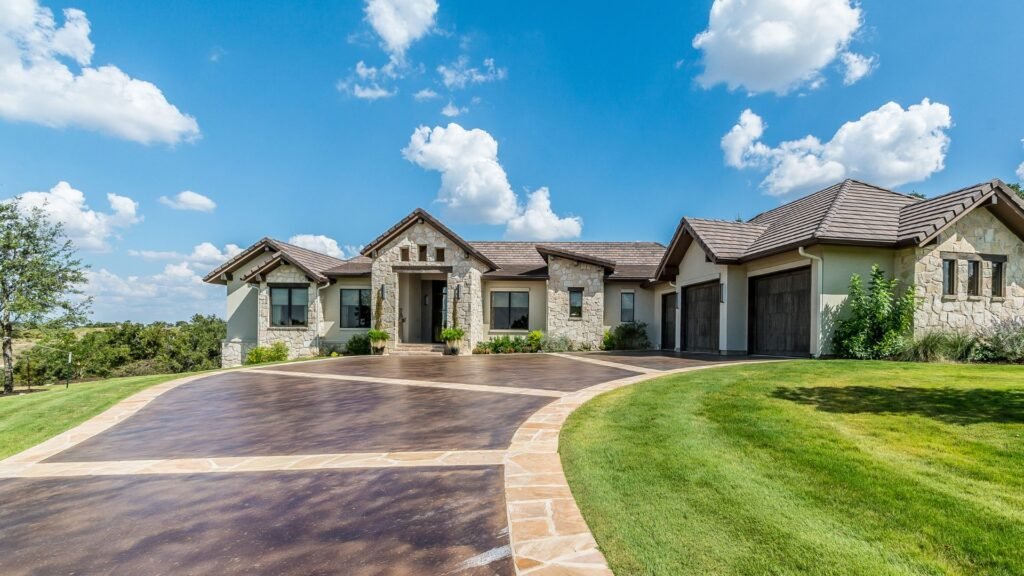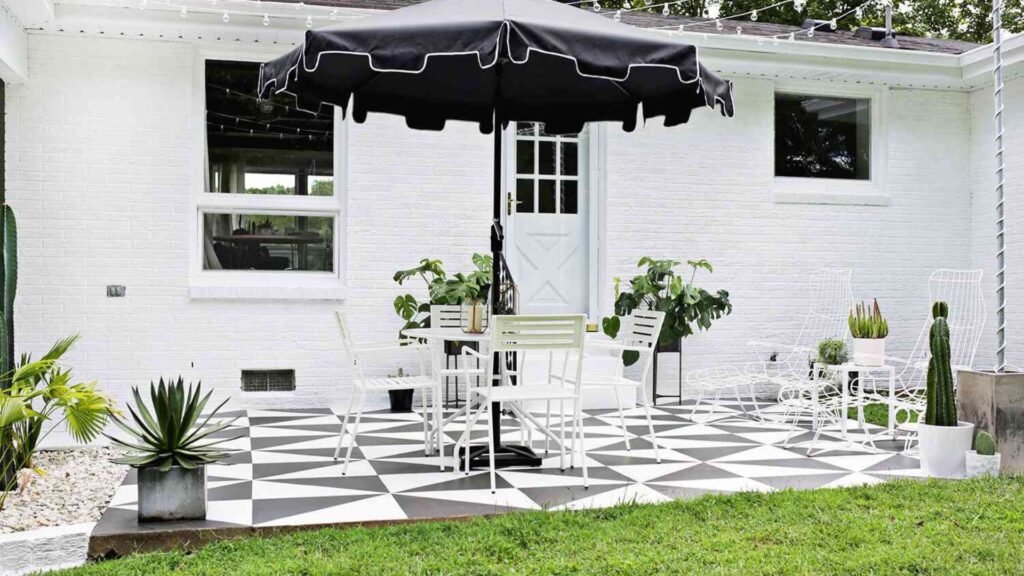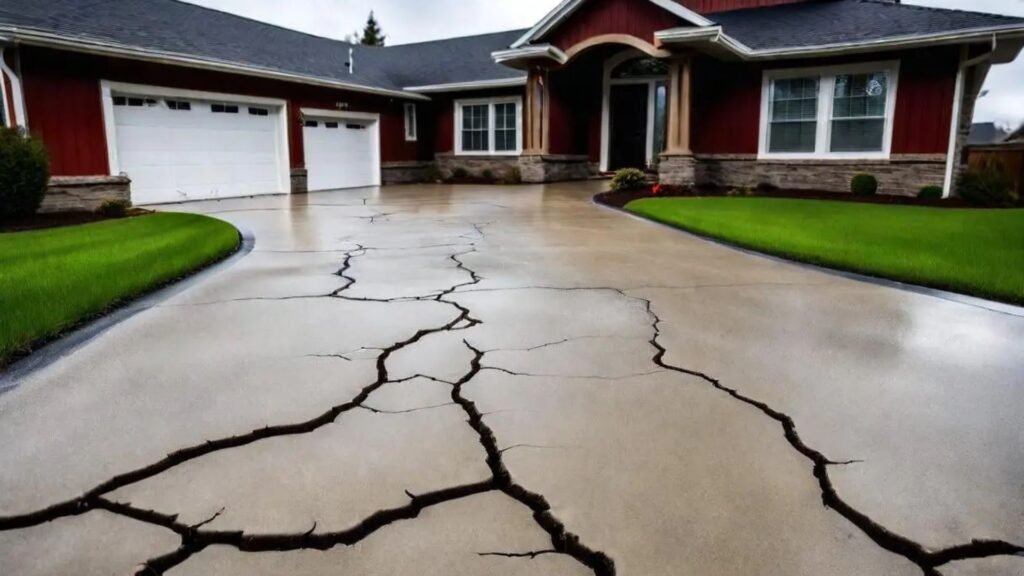Welcome to our comprehensive guide on understanding the key differences between stamped and stained concrete, two of the most popular options for adding style and functionality to your outdoor and indoor spaces. Whether you’re a homeowner looking to enhance your patio, driveway, or flooring, choosing between these two concrete finishing techniques can be a challenge. Stamped concrete offers the look of high-end materials like stone or brick with textured designs, while stained concrete provides a sleek, artistic finish with vibrant colors. In this post, we’ll break down everything you need to know about these options, including cost, durability, maintenance, and design versatility, so you can make an informed decision that best suits your home improvement needs.
The main difference between stamped and stained concrete lies in their appearance and application. Stamped concrete is textured and patterned to mimic materials like stone, brick, or wood, offering a more three-dimensional look. Stained concrete, on the other hand, uses colorants to create rich, translucent tones that enhance the surface’s natural texture without altering its physical structure. While stamped concrete provides a textured finish, stained concrete focuses on adding color and depth for a sleek, artistic appearance. Both options offer durability and versatility for indoor and outdoor spaces, but differ in cost, maintenance, and design flexibility.
Table of Contents
What Is Stamped Concrete?
Definition and Overview
Stamped concrete is a type of decorative concrete that has become increasingly popular for both residential and commercial applications. It involves the process of pouring standard concrete, which is then enhanced with textures, patterns, or colors to give the appearance of more expensive materials like brick, stone, or wood.
The process typically begins with the pouring of wet concrete onto a prepared surface. Before the concrete sets, a specialized tool is used to imprint a desired pattern or texture. Common patterns mimic natural stone, slate, tile, brick, or even wood grain. Coloring agents, such as dyes or stains, can be added either during or after the stamping process to achieve a customized and visually appealing finish.
The key appeal of stamped concrete lies in its ability to replicate high-end materials at a fraction of the cost. Homeowners and business owners can achieve the luxurious look of natural stone or brick without the hefty price tag or labor-intensive installation process that comes with traditional masonry work.
Benefits of Stamped Concrete
One of the standout features of stamped concrete is its aesthetic versatility. Whether you want to replicate the rustic appearance of cobblestone streets, the sleek modern look of tile, or the natural warmth of wooden planks, stamped concrete can be customized to match almost any design vision. This makes it a popular choice for driveways, patios, walkways, and even pool decks.
Beyond its aesthetic appeal, stamped concrete is incredibly durable. When installed correctly, it can handle heavy foot traffic, vehicles, and the elements, making it ideal for both indoor and outdoor use. The durability of stamped concrete means that it will maintain its look and function for many years with minimal wear and tear, especially when compared to real stone or pavers that can shift or settle over time.
From a financial perspective, stamped concrete is highly cost-effective. While natural stone or brick surfaces can be expensive to purchase and install, stamped concrete provides a similar high-end look at a much lower price point. You can achieve the beauty of premium materials without breaking the bank, which is why many property owners prefer it.
Customization is another key benefit. There are virtually endless possibilities when it comes to patterns, textures, and colors. Whether you’re looking for a sleek, modern finish or a classic, earthy tone, stamped concrete can be tailored to fit your aesthetic preferences. In addition to standard colors, concrete can be enhanced with antiquing agents or multiple color layers for more depth and realism.
Drawbacks of Stamped Concrete
While stamped concrete offers many benefits, it is not without its drawbacks. One of the primary challenges is the labor-intensive installation process. Stamped concrete requires professional expertise to ensure that the pattern is applied correctly and the finish looks seamless. Poor installation can result in uneven surfaces, visible seams, or misaligned patterns, which can detract from the overall appearance.
Another concern with stamped concrete is the risk of cracking. Like all concrete surfaces, stamped concrete can crack over time, particularly if it’s exposed to extreme weather conditions, heavy loads, or improper maintenance. While proper installation and the use of control joints can help minimize the risk of cracking, it is still a possibility that homeowners should consider.
In terms of maintenance, stamped concrete does require some upkeep to preserve its appearance and durability. One of the key maintenance tasks is resealing the surface every few years. This is necessary to protect the concrete from moisture, UV rays, and wear and tear. Without regular sealing, the colors may fade, and the surface can become more vulnerable to damage.
Stamped concrete is a versatile, durable, and cost-effective option for those looking to enhance their property’s appearance. However, it does require professional installation and periodic maintenance to ensure its longevity and beauty. By weighing the benefits and drawbacks, property owners can decide whether stamped concrete is the right choice for their next project.
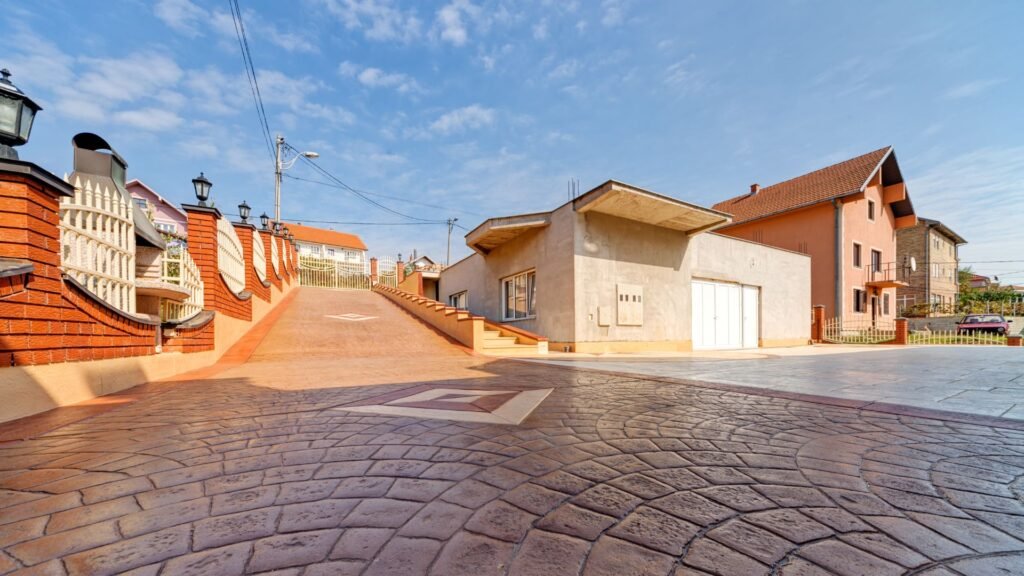
What Is Stained Concrete?
Definition and Overview
Stained concrete is a decorative technique that enhances the appearance of concrete surfaces by adding rich, translucent color. Unlike traditional painting, which coats the surface, staining involves the application of chemical or acid-based stains that penetrate the concrete. This process creates unique, variegated colors that are often compared to marble or natural stone.
There are two main types of stains: acid-based and water-based.
- Acid-based stains chemically react with the concrete, causing a permanent change in color. This reaction produces natural, earth-toned shades that are unique to each surface.
- Water-based stains are less reactive, providing a more consistent surface-level color application. These stains offer a broader range of hues, including brighter and more vibrant colors.
Benefits of Stained Concrete
Stained concrete is highly sought after for its distinct visual appeal and range of practical benefits:
- Unique Appearance: No two stained concrete surfaces are exactly alike. The chemical reactions in acid-based stains ensure that each floor, patio, or driveway has its own unique color patterns, making it a popular choice for homeowners seeking a creative, one-of-a-kind look.
- Wide Color Options: Stained concrete offers an extensive palette of colors, from rich, earthy tones to more vibrant hues. Acid stains tend to produce more natural, muted colors, while water-based stains can provide a wide range of bright or subtle tones, creating depth and dimension on any surface.
- Low Maintenance: Once sealed, stained concrete requires minimal upkeep. The sealed surface resists dirt and moisture, making it a low-maintenance solution compared to other decorative flooring options. With proper care, stained concrete can last for many years without frequent cleaning or refinishing.
- Versatility: Stained concrete can be applied to both new and existing concrete, making it a flexible option for renovation projects or new builds. Whether you’re updating an old surface or starting fresh, stained concrete can adapt to various design styles and locations, from interior floors to exterior patios.
Drawbacks of Stained Concrete
While stained concrete offers many advantages, there are some potential drawbacks to consider:
- Limited Texture Options: Stained concrete primarily enhances color, but it doesn’t add texture to the surface. If you desire a textured finish, such as the look of stone or brick, stamped concrete might be a better option. Stained concrete focuses more on visual aesthetics than physical texture.
- Fading Over Time: Although durable, stained concrete may fade with prolonged exposure to UV rays or harsh weather conditions, especially in outdoor applications. To maintain its vibrant color, stained concrete surfaces may need resealing or touch-ups every few years.
- Susceptibility to Surface Damage: Since stains don’t cover imperfections, any cracks or flaws in the concrete surface may become more visible after staining. Proper surface preparation, including patching and cleaning, is essential for achieving a flawless result.
Stained concrete is a versatile and attractive option for adding color and style to concrete surfaces. With its unique appearance, wide color range, and low maintenance requirements, it’s a favorite for both indoor and outdoor spaces. However, it’s important to weigh the limitations, such as the lack of texture and potential fading, when considering it for your project.

Key Differences Between Stamped And Stained Concrete
Concrete is one of the most versatile materials available for building and design. Both stamped and stained concrete are popular choices for homeowners and designers, but they serve different purposes and provide distinct aesthetic results. Let’s explore the key differences between the two.
Aesthetic Differences
- Stamped Concrete: This type of concrete focuses on creating visual and tactile texture. The stamping process replicates the look of materials like brick, stone, or tile, offering a more dimensional appearance. Homeowners often choose stamped concrete to create a realistic, textured finish that elevates outdoor spaces. It gives patios, pool decks, and driveways a more natural and organic feel, often resembling high-end materials at a fraction of the cost.
- Stained Concrete: On the other hand, stained concrete prioritizes color over texture. The stain penetrates the surface of the concrete, producing smooth, artistic effects. The final look can be variegated, mottled, or even translucent, giving a unique, often customized appearance. The aesthetic is typically sleek and modern, making it a popular choice for interior floors or minimalistic outdoor areas.
Installation Process
- Stamped Concrete: The installation of stamped concrete is labor-intensive and requires a high degree of skill. The process begins when the concrete is poured and then stamped before it sets. This involves pressing molds into the wet surface to create the desired pattern. After the stamping process, colorants are added, and a sealant is applied to protect the surface. Due to the complexity of the process, it generally takes longer to install than stained concrete.
- Stained Concrete: The process of staining concrete is simpler and faster. The stain is applied to an already cured surface, so there is no need to work with wet concrete. After cleaning and preparing the surface, the stain is applied in layers, which can be customized depending on the desired color intensity. Once the stain is absorbed, a protective sealant is applied to maintain the color. Overall, staining concrete requires less labor and can often be completed more quickly.
Durability and Maintenance
- Stamped Concrete: Stamped concrete is durable, but it is more prone to cracking, especially in climates that experience temperature fluctuations. Over time, water and ice can cause the concrete to shift and crack, which requires occasional repairs. To maintain its appearance and prevent damage, stamped concrete needs to be resealed every few years. Regular maintenance can help prolong its life, but neglecting resealing can lead to fading, cracks, and surface degradation.
- Stained Concrete: In contrast, stained concrete is highly resistant to weathering, heavy traffic, and the elements. The stain penetrates deep into the concrete, making it less likely to peel or chip. This characteristic makes it ideal for areas with high foot traffic or exposure to moisture. While it does require occasional resealing to preserve the vibrancy of the color, stained concrete generally requires less upkeep compared to stamped concrete.
Cost Comparison
- Stamped Concrete: Stamped concrete tends to be more expensive than stained concrete due to the labor-intensive installation process. The cost of materials, skilled labor, and the detailed stamping work contribute to a higher price. However, for many homeowners, the investment is worth it due to the visual appeal and durability that stamped concrete offers, especially in outdoor applications where texture is important.
- Stained Concrete: Stained concrete is generally more affordable, making it a cost-effective solution for large surface areas. Since the installation process requires less labor and expertise, it is often the more economical choice for projects that prioritize color over texture. Its affordability makes stained concrete a popular option for both interior and exterior design projects, especially where a clean, modern look is desired.
Application Suitability
- Stamped Concrete: Stamped concrete is ideally suited for outdoor areas where both texture and durability are important. It is commonly used in patios, driveways, pool decks, and walkways, where a textured, non-slip surface is beneficial. The ability to replicate the look of natural stone or brick makes it a favorite for outdoor spaces where aesthetics matter.
- Stained Concrete: Stained concrete is more often used in interior spaces, particularly for decorative flooring. It’s also a good option for outdoor applications that don’t require a textured surface. Walkways, patios, and even garage floors benefit from stained concrete’s smooth, colorful finish, making it ideal for spaces that focus more on color design than texture.
Both stamped and stained concrete have their own set of advantages depending on the desired outcome. Stamped concrete offers a more textured, natural look, making it perfect for outdoor use, while stained concrete focuses on vibrant color and smooth finishes, often used for indoor flooring. Understanding these key differences will help you choose the right option for your project based on aesthetics, installation, durability, cost, and application.

Choosing Between Stamped And Stained Concrete
When deciding between stamped and stained concrete for your next project, it’s crucial to weigh the pros and cons of each option in terms of cost, aesthetics, maintenance, and durability. Below, we break down the key considerations to help you make an informed decision.
Consider Your Budget
Budget is often the first factor people consider when choosing between stamped and stained concrete. Stamped concrete tends to be more expensive due to the extensive labor involved in applying detailed patterns and textures. The cost can vary depending on the level of customization, but typically, it involves higher material and labor costs than stained concrete.
Stained concrete, on the other hand, is generally more affordable because it involves a simpler process of applying color treatments to the surface of the concrete. While the color and finish can be beautiful and artistic, stained concrete doesn’t require the same level of intensive labor as stamping, making it a cost-effective solution for many homeowners or businesses.
Think About Your Desired Aesthetic
Your vision for the finished look is another crucial factor in determining whether stamped or stained concrete is right for you.
If you want a more textured, high-end appearance that replicates the look of natural materials like stone, wood, or tile, stamped concrete may be your best choice. It offers endless design possibilities, allowing for intricate patterns and a wide array of color combinations. Many homeowners opt for stamped concrete when they want to enhance the visual appeal of outdoor spaces, such as patios and walkways, creating a luxurious feel.
On the other hand, stained concrete is ideal if you’re aiming for a more artistic and contemporary aesthetic. Staining can provide a variety of vibrant, translucent colors, giving the concrete a sleek, minimalist finish. It’s often used in indoor spaces, modern homes, and commercial settings, where a simpler yet stylish look is desired. The final appearance of stained concrete can range from subtle earth tones to bold, vivid hues, offering flexibility to match your design preferences.
Consider Durability and Maintenance Needs
In terms of maintenance, both options have their unique requirements. Stamped concrete may require more frequent upkeep due to its textured surface. It needs to be regularly resealed to maintain its aesthetic appeal, as exposure to weather elements can cause fading, cracking, or erosion over time.
Stained concrete, however, typically requires less maintenance. Its smooth surface is easier to clean, and while it also benefits from occasional resealing, it generally holds up well with minimal effort. The resealing process for stained concrete is usually less intensive, and it helps preserve the color and finish for years.
Longevity and Weather Conditions
When it comes to longevity, climate plays a big role in how well each option performs over time. In regions with extreme weather fluctuations, stained concrete may be a better choice due to its smoother surface, which is less prone to cracking. Its ability to expand and contract with changing temperatures helps maintain its structural integrity.
Stamped concrete, while durable, is more susceptible to cracking, especially in climates with freezing and thawing cycles. The textured surface can sometimes trap moisture, leading to issues over time. However, proper installation and sealing can mitigate some of these concerns, ensuring your stamped concrete lasts for years.
Choosing between stamped and stained concrete comes down to your budget, aesthetic preferences, maintenance tolerance, and local weather conditions. Both options provide durable, visually appealing finishes, but understanding the pros and cons of each will help you achieve the perfect outcome for your space.
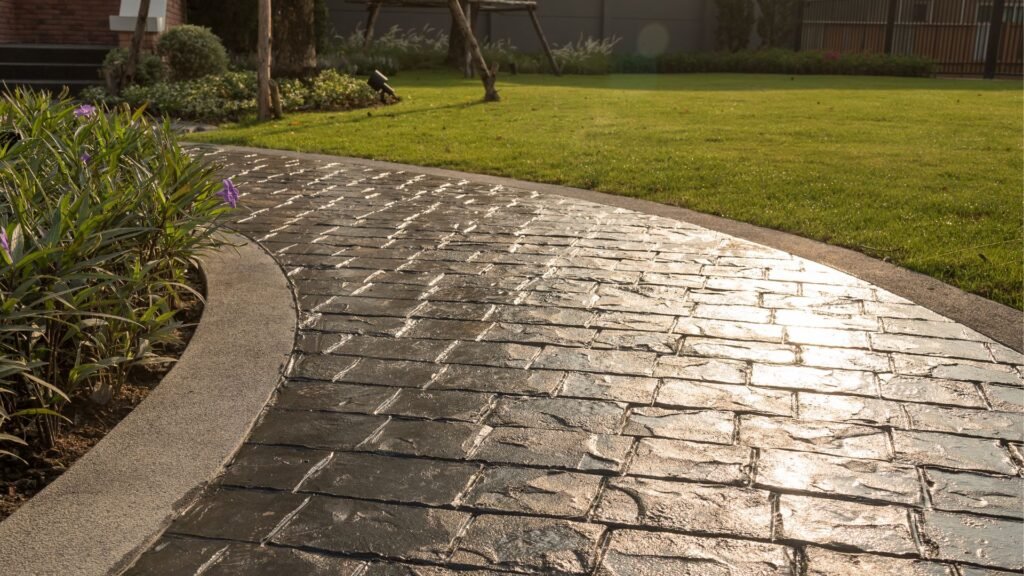
Real-World Examples And Testimonials
Concrete has become more than just a structural material. With advancements in design techniques, both stamped and stained concrete have transformed into beautiful options for enhancing the look of various spaces. Let’s explore some real-life examples of how homeowners and contractors have embraced these innovative concrete solutions and hear what they have to say.
Real-Life Examples of Stamped Concrete
Stamped concrete is a popular choice for outdoor applications because of its durability and aesthetic appeal. One striking example is an outdoor patio featuring a cobblestone pattern. Homeowners selected stamped concrete because it mimics the charm of traditional stone at a fraction of the cost, and the added texture provides a non-slip surface, making it both practical and beautiful. Another common use of stamped concrete is in driveways, where patterns resembling brick or slate add a touch of luxury without the high maintenance requirements of natural materials.
One homeowner in California remarked, “We chose stamped concrete for our driveway, and it has completely transformed our curb appeal. The best part is how low maintenance it is compared to the natural stone we were initially considering.”
Contractors also speak highly of the versatility of stamped concrete. A local contractor in Texas explained, “I recommend stamped concrete to many clients looking to enhance their outdoor spaces. It’s easy to customize, and the design possibilities are endless. From European fan designs to wood-plank patterns, stamped concrete can elevate any space.”
Real-Life Examples of Stained Concrete
When it comes to indoor spaces, stained concrete is a go-to solution for creating sleek, modern aesthetics. In one example, a homeowner in Chicago used stained concrete for their basement floor. They opted for an earthy brown tone, giving the space a warm and inviting feel. Stained concrete is also a hit in kitchens, where its unique coloring provides a contemporary touch while offering easy cleaning and durability.
Minimalist patios are another great place for stained concrete, as it adds a subtle, artistic flair. “I love how our stained concrete patio looks,” says a homeowner from Arizona. “We wanted something artistic, but low maintenance. The custom stain we chose reflects our style perfectly.”
Stained concrete enthusiasts often rave about its ability to create one-of-a-kind looks. An interior designer shared, “Stained concrete allows for a lot of creativity. Whether you’re looking for a marbled effect or a uniform finish, it’s an excellent way to make a statement without breaking the budget.”

FAQs: About What’s The Difference Between Stamped And Stained Concrete?
What is stamped concrete?
Stamped concrete is a type of decorative concrete where patterns, textures, or designs are imprinted into the surface while it’s still wet. This process allows the concrete to mimic materials like brick, stone, or wood, providing a textured and detailed finish.
What is stained concrete?
Stained concrete involves applying colorants or chemical stains to the surface of cured concrete. These stains penetrate the surface to create rich, translucent tones, enhancing the natural look of the concrete without adding texture.
Which is more expensive, stamped or stained concrete?
Stamped concrete is generally more expensive than stained concrete due to the labor-intensive process of stamping, texturing, and sealing. Staining is a simpler process, making it a more affordable option, especially for larger areas.
Which option lasts longer, stamped or stained concrete?
Both stamped and stained concrete are durable and long-lasting when properly installed and maintained. However, stamped concrete may require more maintenance over time due to the risk of cracking, especially in areas with fluctuating weather conditions.
Can you combine stamping and staining concrete?
Yes, you can combine both techniques. It’s possible to stamp the concrete for texture and then stain it for added color and depth. This offers a unique, customized look that incorporates both design elements.
Is stamped concrete slippery when wet?
Stamped concrete can become slippery when wet, especially if it has a smooth or sealed surface. However, this can be mitigated by adding a non-slip additive to the sealant or choosing a more textured pattern.
Does stained concrete fade over time?
Stained concrete can fade over time, particularly if exposed to sunlight and harsh weather conditions. Regular sealing can help maintain the vibrancy of the colors and protect the surface from fading.
How often do you need to reseal stamped and stained concrete?
Both stamped and stained concrete should be resealed every 2 to 3 years, depending on usage, weather exposure, and the type of sealant used. Resealing helps protect the surface from wear and tear, fading, and staining.
Can I stain existing concrete?
Yes, you can stain existing concrete as long as the surface is in good condition. The concrete must be clean and free of cracks or major imperfections, as these flaws will still be visible after staining.
What areas are best suited for stamped or stained concrete?
Stamped concrete is ideal for outdoor spaces like patios, driveways, and walkways where textured surfaces are desired. Stained concrete is commonly used for indoor spaces like floors, basements, and minimalist outdoor areas where color and design are the main focus.
Conclusion
In conclusion, while both stamped and stained concrete offer unique benefits, they differ in key areas such as visual appeal, cost, maintenance, and durability. Stamped concrete provides a textured surface that mimics the appearance of more expensive materials like stone or brick, while stained concrete offers vibrant, customizable colors with a sleek finish. Stamped concrete tends to be more expensive due to the intricate designs and labor involved, while stained concrete can be a more budget-friendly and low-maintenance option. Durability is strong with both, but stamped concrete may require more maintenance to prevent cracking. Ultimately, the best choice depends on your specific project needs—whether you prioritize detailed patterns or prefer a colorful, low-maintenance surface. It’s crucial to consult with a professional to ensure proper installation and maximize the benefits of your chosen material. If you’re considering decorative concrete for your home renovation project, don’t hesitate to explore more options or reach out for a free consultation to make an informed decision.
About the Author:
Mike Veail is a recognized digital marketing expert with over 6 years of experience in helping tradespeople and small businesses thrive online. A former quantity surveyor, Mike combines deep industry knowledge with hands-on expertise in SEO and Google Ads. His marketing strategies are tailored to the specific needs of the trades sector, helping businesses increase visibility and generate more leads through proven, ethical methods.
Mike has successfully partnered with numerous companies, establishing a track record of delivering measurable results. His work has been featured across various platforms that showcase his expertise in lead generation and online marketing for the trades sector.
Learn more about Mike's experience and services at https://theleadguy.online or follow him on social media:
